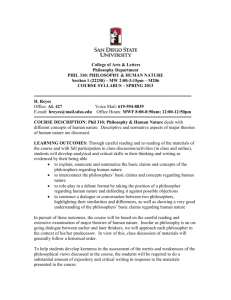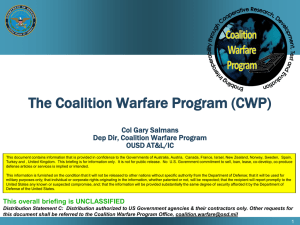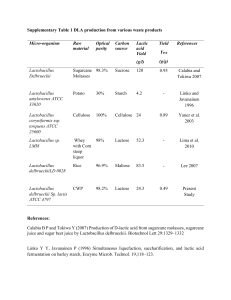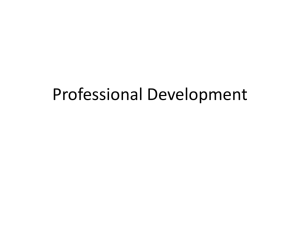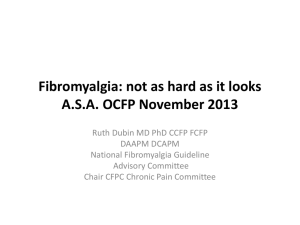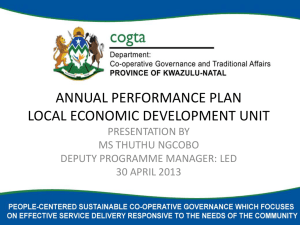Construction Work Packages - Construction Owners Association of
advertisement
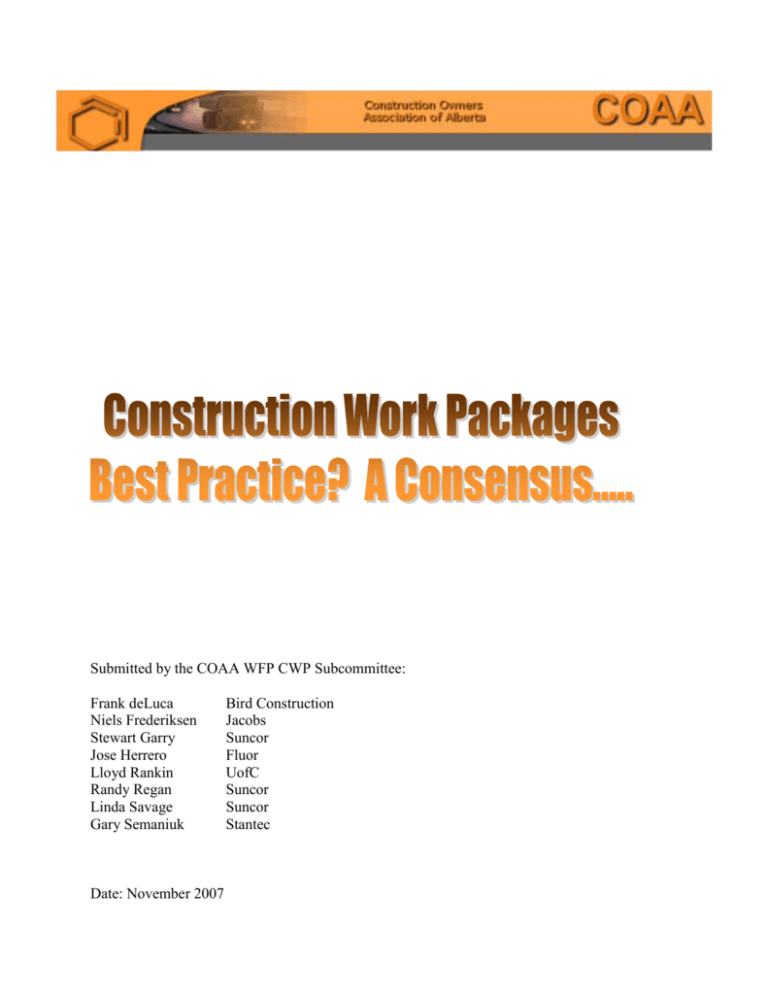
Submitted by the COAA WFP CWP Subcommittee: Frank deLuca Niels Frederiksen Stewart Garry Jose Herrero Lloyd Rankin Randy Regan Linda Savage Gary Semaniuk Date: November 2007 Bird Construction Jacobs Suncor Fluor UofC Suncor Suncor Stantec Table of Contents Table of Contents ................................................................................................................ ii Executive Summary ........................................................................................................... iii Introduction ......................................................................................................................... 1 CWP Literature ................................................................................................................... 1 Definitions........................................................................................................................... 3 CWP Template .................................................................................................................... 4 CWP Flow........................................................................................................................... 4 Conclusion .......................................................................................................................... 6 References ........................................................................................................................... 7 Frequently Asked Questions ............................................................................................... 7 Appendix A - CWP Flow Chart .......................................................................................... 8 Appendix B - CWP Template ............................................................................................. 9 ii Executive Summary An assumption was made during the development of the Construction Owners Association of Alberta (COAA) WorkFace Planning (WFP) model that the term construction work package (CWP) was known and accepted in industry. As WorkFace Planning initiatives gained steam, reports by COAA members revealed different levels of definition around the term CWP. A subcommittee was formed to define the CWP and to determine if CWPs can be considered a best practice in relation to WFP and the development of field installation work packages (FIWPs). The literature review made it clear that work packaging is not a new concept. Construction work packages on the other hand have developed in an environment where there are many different types of construction that have different needs, different systems, not to mention the different types of companies (E, EP, EPC EPCM, C). It is no surprise then that construction work packages do not look the same, have the same name or have all the same attributes. The basic premise of work packaging whether it is a construction, engineering, procurement or field installation work package is rooted in the idea that a project is broken into well defined manageable pieces that can be executed, budgeted, measured and controlled. CWP are sometimes used for contracting purposes. This report focuses on the use of CWPs for construction planning purposes as it pertains to the WorkFace. The distinction is that a CWP is a construction deliverable that defines a specific scope of work and should include a budget and schedule that can be compared with actual performance. The boundaries of the CWPs, the complete list and the priorities must be developed by Construction during the front end of the Engineering phase, in conjunction with the path of Construction so the sequence of the Engineering and Procurement deliverables can support the Construction requirements. The CWPs are assembled by Construction before the work gets to the field. The CWP will always include a description of the work, list of drawings and materials/equipment to be installed, reference documents (such as P&ID’s, specifications, etc.) and should include estimated manpower, scaffolding and construction equipment requirements, safety, quality, subcontract administration, permitting and regulatory requirements. CWPs are rolled out in a staged process, updated as information becomes available at different schedule levels and are continually refined into FIWPs. The CWP is a prerequisite of the FIWP, it is not the detailed plans for the WorkFace it is the high level forethought that can be reasonably captured by senior level construction. A CWP template was developed in order to harness consistency in the construction industry with respect to CWPs. This can be viewed in Appendix B - CWP Template. The “how” of execution is addressed in the CWP flow chart in Appendix A - CWP Flow Chart and as a narrative in the section entitled CWP Flow. Today COAA endorses WorkFace Planning as a best practice; CWPs are a prerequisite to this best practice. Consistent use of the CWP packaging process will help projects to align construction plans with engineering and procurement and as a consequence improve the overall project execution and management. iii Introduction An assumption was made during the development of the Constructing Owner Association of Alberta (COAA) WorkFace Planning (WFP) model that the term construction work package (CWP) was known and accepted in industry. As WorkFace Planning initiatives gained steam, reports by COAA members active in WFP in industry revealed different levels of definition around the term CWP. A subcommittee was formed to define a CWP and to determine if CWPs can be considered a best practice in relation to WFP and the development of field installation work packages (FIWPs). The subcommittee’s strategy for determining if a CWP can be called a best practice included: research into the origins of the CWP, discussion around the need for and characteristics of the CWP, the development of a CWP flow chart, a CWP template, a formal report, the presentation of the CWP findings and conclusions to the WFP committee for discussion and consensus. CWP Literature The majority of the theory and the practical application of work packaging are from the late 70’s and 80’s. CII developed an information publication on work packaging in 1988. During the 90’s software was developed based on the concept of work packaging. A paper written in 2006 called “Effective Construction Work Packages” was not theoretical in nature but a practical application of the work packaging process specific to the oil and gas industry. Based on this information we can answer such questions as why work packaging, what is it, what are the objectives, how do we do it and how does it relate to WFP? Why develop work packages? Why develop construction work packages? The question of why construction work packaging is being raised is not only because WorkFace Planning has identified CWPs as part of the WFP process but because recent studies around productivity improvement, tool time and data collected in lessons learned sessions draw attention to areas that are governed by CWPs. These include alignment between the Engineering and Construction functions, estimate and schedule risk analysis, forecasting scaffolding and construction equipment requirements, safety, quality, subcontract administration, permitting, etc. “The CWP process was developed as a result of root cause analysis, lessons learned and the need to take a more proactive approach to project execution.” [5] This means involving construction in the front end planning because classically “the project is designed (engineered) with a top down approach. Detail increases as major systems are defined and expanded from the concept to the working design level…In contrast, construction occurs in a bottom up fashion. Individual work activities are synthesized to construct modules which ultimately work together as systems…This orientation to plan and control by area is in direct contrast to the system orientation of the design process…The work packages… for engineering will 1 be system oriented and focus on work product such as drawings, specifications, and studies. During construction, work packages…will focus on area and component and will result in work product such as duct installation and concrete placement.” [2] Being involved in the front end is not just about defining the boundaries, the priorities and eventually developing CWPs but it entails construction planning, developing a solid execution plan , constructability reviews, managing project (and construction) risks, lessons learned data base review and preparing adequate schedule and budget baselines for the construction phase.. Construction work packages are developed to describe the construction scope of work and facilitate the integration between cross functional disciplines. “The CWP provides integration between construction and estimating, field engineering, safety, project controls, (quality) and materials management. This process does not eliminate the need for effective WorkFace Planning, but rather forms an integral part.” [5] WorkFace Planning has an expectation of having the right things provided to the right people at the right place and time. This requires preplanning and appropriate lead time for cross functional teams such as engineering and supply chain to be able to provide the necessary drawings and materials when construction needs them. That lead time starts at the CWP level and is broken down to more precise requirements in the FIWP. What are the objectives of work packaging? “The objectives of work packaging are to reconcile the differences of planning, scheduling, budgeting, status and control implied by the system orientation of design, procurement, start up and operation and the area orientation of construction. By effective work packaging, these differences can be addressed in a uniform manner so that integrated project management is possible.” [2] Not only to reconcile the differences of planning but to actually plan the work. How do we execute the work package process? CWPs remained a theory for much of the 1970’s and into the early 1980’s leaving the “how” out, except in isolated cases of large EPC companies. “Previous research has been devoted to examining the conceptual applicability of the work packaging concept and applying it as a general managerial tool. Only limited attention has been paid to the actual work packaging process” [3] CII addressed the “how” of work packaging by developing an easy to follow information publication defining the entire work package process as it relates to Project Controls and the Work Breakdown Structure. Areas of engineering, procurement and construction are detailed in individual or separate work packages. They define an engineering work package or EWP and a procurement work package or PWP and a construction work package or CWP and finally a crew work package. CWPs according to CII are a staged process, updated as information becomes available at different schedule levels; this is confirmed by a recent paper called “Effective Construction Work Packages”. The CII defined CWP is continually refined into crew work packages or what we now call field installation work packages (FIWPs). The COAA model deviates from the CII model in that it does not recommend a hard connection to Project Controls. The FIWPs are still schedule driven but progress and performance is not necessarily measured at the FIWP level. The driver for developing construction work packaging is to draw in construction 2 early enough to affect change and preplan with expertise before the work gets to the field. The FIWP addresses the planning of the work in the field such that the right things get to the right people at the right place and time. This is all very generic and is meant to be a model to any kind of construction. Each construction company that implements WorkFace Planning will have different systems, ideas and process to make WorkFace Planning work for them. However by following the basic COAA road map the industry can communicate at a high level what its needs and expectations are at the WorkFace. The “how” of execution is addressed in the CWP flow chart in Appendix A - CWP Flow Chart and in a narrative in the section entitled CWP Flow. Perhaps it is also a question of when. How much advance notice does Engineering and Materials Management need from Construction about the CWP boundaries and the priorities so they can get the necessary items to Construction in time so the CWPs can be compiled with all the correct information? When should construction get involved to ensure their needs are met? When should Construction start assembling the CWPs? By involving construction in the early stages of EDS and having a clear understanding of the roles and responsibilities of each group, it is anticipated that the efficiency of the overall process can be improved. There are many different types of project execution strategies (E, EP, EPC EPCM, C) and commercial approaches. It is no surprise then that work packages do not look the same, have the same name or have all the same attributes. Definitions What is the definition of a work package? Some of the definitions found in the literature for work packaging include; “A Work Package is a well defined scope of work that terminates in a deliverable product(s) or completion of a service. Each package may vary in size, but it must be a measurable and controllable unit of work to be performed. To complete a work package, one or more tasks will be performed. Thus, a work package may encompass the work of more than one crew or staff.” [2, CII] “Work Breakdown Structure elements of the project isolated for assignment to “work centers” for accomplishment. Production control is established at this element level.” [PMI] “Small, discrete element of work (called packages) that are budgeted with realistic but challenging targets and are assigned to supervisors to be completed in a relatively short period of time. Actual costs are collected and compared to the budget as the work packages are completed. Based on the data collected, progress is analyzed and action is taken to control the project according to plan.” [1] 3 COAA proposes the following definitions for the WFP model. Construction Work Package (CWP) - A construction work package is an executable construction deliverable that defines in detail a specific scope of work and should include a budget and schedule that can be compared with actual performance. The scope of work is such that it does not overlap another CWP and can be used as a scoping document for Requests for Proposal and Contracts. Engineering Work Package (EWP) - An engineering work package is an engineering deliverable that is used to develop CWPs and that defines a scope of work to support construction in the form of drawings, procurement deliverables, specifications and vendor support and that is released on an agreed upon sequence consistent with the CWP schedule. The scope of work is typically by discipline by area. Field Installation Work Package (FIWP) - A field installation work package is a detailed execution plan that ensures all elements necessary to complete the scope of the FIWP are organized and delivered before work is started to enable craft persons to perform quality work in a safe, effective and efficient manner. Generally the scope of work associated with the FIWP should be small enough that it could be completed by a single foremen team in a one or two week time frame. CWP Template What does a construction work package look like? A CWP template was developed in order to set the bar for package content. The cover page which includes title block, sign off block and table of contents will probably look different for each company though the table of contents sections should remain the same regardless of the type of construction in order to harness consistency in the construction industry with respect to CWPs. This can be viewed in Appendix B - CWP Template. The CWP elements were chosen as a result of a gap analysis comparing CWPs from various sources and referencing the CII definition of a construction work package. Not all elements will apply to all CWPs. They will differ depending on the industry, discipline and scope of work. It is recommended that NO categories are deleted in a CWP template but rather a statement of not applicable (NA) be used. Additions to the CWP are encouraged where they are construction related or impact construction in a way that warrants recording the information at that level. CWP Flow The following describes the work flow for CWP development from project inception to CWP breakdown into FIWPs. Appendix A - CWP Flow Chart is an illustration of the narrative below. The Project Manager prepares the Project Execution Plan (PEP) which among other things includes documenting the implementation of work packaging. The Project Construction Director prepares the preliminary Construction Execution Plan (CEP) for 4 insertion into the PEP which will detail the engineering, construction and field installation work package processes and procedures. In addition develops the path of construction. Next engineering, whether it is an EP/EPC/EPCM contractor, provides the preliminary overall Project Plot Plan and the Construction Contractor then develops the path of construction. Once that is done the constructability process is initiated. “Constructability is the effective and timely integration of construction knowledge into the conceptual planning, design, construction and field operations of a project to achieve the overall project objectives in the best possible time and accuracy, at the most cost-effective levels.” [6] This process brings engineering and construction together to understand and confirm agreement on the path of construction previously developed . In the absence of the Construction Contractor, the Construction Management team takes on duties until such time as the Construction Contractor is signed. Ideally the construction contractor is brought on no later than early EDS. The Construction Contractor then generates a preliminary CWP list, and definitions (boundaries). The Construction Contractor meets with the Engineering Contractor to review the CWP list and definitions and discuss the logical sequence of the CWP packaging, its prioritization and the scheduled release or need dates. Where Engineering has difficulty in accommodating a definition or prioritization, both the Construction Contractor and the Engineering Contractor will discuss the CWP Plan and together with the Owner decide upon the best balanced solution for the benefit of the project. After this discussion and subsequent agreement, Engineer will incorporate these definitions into the appropriate EWPs, adapt as required the engineering process and report progress by EWP in an agreed upon manner with the Owner. The EP/EPC/EPCM Contractor will establish 3D Model Areas (or partitions) and sets up EWP by discipline; these will be finalized in the Detail Design Phase and target review and completion dates for the different Areas will be inserted into the Project Schedule. The scheduled EWPs will align with the agreed to CWP Plan. Before construction starts the Construction Contractor will determine preliminary overall project temporary facilities, craft and indirect manpower requirements. This information is used to update the CEP. EP/EPC/EPCM Engineering Contractor EWP Coordinator should compile all information and documents required as part of the specific EWP and release the information by EWP to the Construction Contractor via the specified Project Document Management System. EWP Updates and Revisions will be released to the Construction Contractor CWP Coordinator in the same way. The Construction Contractor CWP Coordinator will compile all documents and information (as noted in the list below) from the released EWPs into a CWP and then issue it for execution. This CWP will include input from the Construction Management Team (CMT). If so required by the CEP, when the Construction Contractor has completed assembled each individual CWP it is sent to the CMT for review prior to issuing for execution. 5 Items to be considered for inclusion in a CWP: - Construction Scope of Work Engineering (List of related EWPs) Manpower Materials Safety Quality Regulatory Requirements Subcontract Identification Vendor Support Rigging Scaffolding Special Construction Equipment - Special Tools Consumables Waste Management Risk Listing of related CWPs/FIWPs Cleaning requirements Special Temporary Facilities Warehousing Welding Budget and Schedule Winterization Once the CWP is deemed ready for execution (installation and erection) the Construction Contractor will provide a detailed Erection and Installation Plan and start the WorkFace Planning process by creating a preliminary FIWP Release Plan. FIWPs are developed as per the release plan as a break down of CWPs. Field Supplied Material and Owner – Engineering Contractor supplied material are received by the Construction Contractor. The CM Integration Coordinator liaises with the individual Construction Contractor Integration Coordinators to promote optimized use of common commodities (Cranes, Scaffold etc.) between Contractors and disciplines. Work is then executed by FIWP. FIWPs are released one per crew at a time until the work is complete. The Construction Contractor performs the Turnover System Walkdown and generates a Pre Turnover Punchlist and work-off items listed. Some of the Punchlist item may be generated from the FIWP process. Conclusion CWPs are a construction deliverable developed by the construction contractor performing the work at site. It is the preplanning of construction related essentials at the WorkFace that requires early attention and consideration. The CWP is a prerequisite of the FIWP, it is not the detailed plans but the high level forethought that can be reasonably captured by senior level construction. Today COAA endorses WorkFace Planning as a best practice; CWPs are a prerequisite to this best practice. Consistent use of the CWP packaging process will help projects to align construction plans with engineering and procurement and as a consequence improve the overall project execution and management. 6 References 1. Elmore and Sullivan Project Control Through Work Package Concepts 1976 2. Work Packaging for Project Control CII Information Publication, 1988 3. Kim, Jae-Jun and Ibbs, William C. Work Package Process Model for Piping Construction Journal of Construction Engineering and Management, Dec. 1995 4. Choo, Jyun Jeong, Tommelein, Iris D., Ballard, Glenn and Zabelle, Todd R. Work Plan Data Base for Work Package Production Schedule Proceedings IGLC 1998 5. Gardner, George, Effective Construction Work Packages AACE International Transactions, 2006 6. CII Benchmarking Glossary of Terms Version 9.0, accessed from internet September 2007 Frequently Asked Questions 1. Why can’t I go from an EWP to an FIWP? Because the EWP, CWP and FIWP are different things, an EWP is an engineering deliverable, a CWP is a construction deliverable. An EWP is a CWP deliverable, it is part of a CWP. A FIWP is a construction deliverable broken down from a higher level construction deliverable, the CWP. The EWP does not account for scaffolding, construction equipment, subcontractors, manhours etc. 2. Who develops the CWP? The CWP is developed by either the construction contingent of an EPC, the construction contractor who will perform the work. In the absence of the construction contractor the owner construction management team will develop the CWPs. 3. How many EWPs in a CWP? This is dependant on the scope of work but typically there will exist a 1:1 relationship or N:1 where N is the EWP. 4. What is in a CWP? Refer to the CWP template in this document. 7 Appendix A - CWP Flow Chart 8 Appendix B - CWP Template Project Name: Project Number: CWP Number: Area/System/Sub System/Discipline: _____________________________________ _____________________________________ _____________________________________ _____________________________________ TABLE OF CONTENTS 1.0 Construction Scope of Work ....................................................................................... 10 2.0 Engineering Information ............................................................................................. 10 3.0 Craft / Manpower ........................................................................................................ 10 4.0 Direct Field Equipment and Materials ........................................................................ 10 5.0 Safety .......................................................................................................................... 10 6.0 Quality......................................................................................................................... 10 7.0 Special Permits / Regulatory Requirements ............................................................... 10 8.0 Subcontractors............................................................................................................. 10 9.0 Vendor Support Data .................................................................................................. 11 10.0 Rigging Studies ......................................................................................................... 11 11.0 Scaffold ..................................................................................................................... 11 12.0 Special Construction Equipment, Tools and Consumables ...................................... 11 13.0 Waste Management ................................................................................................... 11 14.0 Risk Register ............................................................................................................. 11 15.0 WorkFace Planning ................................................................................................... 11 16.0 Project Control .......................................................................................................... 11 17.0 Turnover Documents ................................................................................................ 11 18.0 Contact List ............................................................................................................... 11 Rev. No 1A Revision Description Date Originator Approvals 9 1.0 Construction Scope of Work A complete narrative description of the construction scope of work for the package. This may include sections for work included and not included, prerequisites, demolitions and isolations as well as a summary of the equipment and bulk quantities to be installed or demolish. 2.0 Engineering Information A listing of the EWPs associated with the CWP, standards, specifications, spec deviations, vendor information, complete list of drawings and revision #’s, PNID’s, Plot Plans, ISOs, holds list, DCN, RFI, Field Survey 3.0 Craft / Manpower Estimate of manpower requirements, direct, indirect, density calculations, special skill requirements 4.0 Direct Field Equipment and Materials Cross reference of PO’s and Equipment list and Instrument list. For Bulk materials: BOM of owner, engineering and or vendor supplied materials and BOM of construction contractor supplied materials. Confirmation of the material status: location at the site warehouse or the ETA of equipment, tags or materials deliveries vs RAS dates. Information about how to update latest ETA information. Special transportation arrangements if the equipment is to be directly installed without unloading it at the warehouse or lay down area. Total quantities as applicable (Ea, tonne, Y3, ft, diainch, etc.) 5.0 Safety High level Job Hazard Assessment that identifies, ranks and sets priorities for hazardous jobs contained in the execution of the CWP. These jobs should be the first priority for analysis and identification times such as: safe work plans, system isolations, special training requirements, special PPE, special permits (confined space, road closures, man baskets, lock outs) WHIMIS. Note: Detailed JHA’s or FLRA’s will take place at FIWP level. 6.0 Quality All the applicable quality control requirements such as ITP’s, weld procedures, non destructive examination, Hydrotest Pressures and P&ID’s, other field tests/checks, survey and as built requirements, ABSA approvals and applicable templates to be filled out for Turnover binders.. 7.0 Special Permits / Regulatory Requirements Review compliance requirements to regulatory approvals and permits. Include applicable special permits required for execution of the CWP (building permits, potable water, disposal, etc) 8.0 Subcontractors Definition of the work to be subcontracted. Subcontractor identification and assessment. Target dates for contract formation process. 10 9.0 Vendor Support Data A list of applicable equipment that requires vendor assistance. Confirmation that a contract or PO is in place which includes specified time allotments. Vendor contact information, notification periods and required dates. 10.0 Rigging Studies Include applicable preliminary heavy lifts and rigging studies, crane rating and identification timeline requirements for the work scope in the CWP. Data related to weights and centres of gravity and lifting lugs provided with the equipment or modules. 11.0 Scaffold Estimated scaffolding types, location, duration and quantity requirements (materials and labour) for the scope of work associated with CWP 12.0 Special Construction Equipment, Tools and Consumables A listing of special equipment, tools and or consumables required for the CWP (e.g. refractory dry-out, laser alignment, etc) 13.0 Waste Management A listing of the types and estimated quantities of waste associated with the CWP and the waste management plan 14.0 Risk Register A listing of items from the risk register that applies to the CWP complete with a status report. 15.0 WorkFace Planning A listing of the proposed FIWPs associated with the CWP and an FIWP release plan 16.0 Project Control This section will include budget, schedule, progress and performance measurements. A detailed Level 3 construction schedule integrated with other construction disciplines and contractors. Progress measurement and performance requirements established and support mechanisms set up. Material quantities and labour rolled up to required WBS levels. 17.0 Turnover Documents List or matrix of required documents for turnover pertaining to the CWP. 18.0 Contact List Contact information of Engineering, Materials Management, Hospitals, Doctors, Vendors, Document Owners etc. 11
